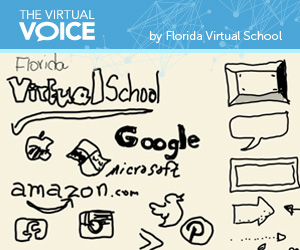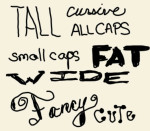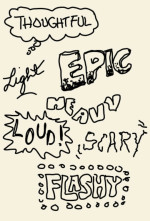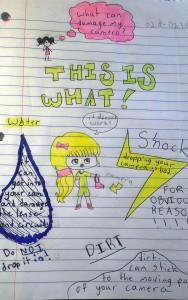Got Notes? (Part 2)
 sketch – note
sketch – note
/skeCH nōt/
Noun
1. A substantially awesome method for taking notes that is easy, fun, and does not require drawing ability (stick figures welcome!)
Verb
2. Combining doodles and notes and increasing your memory retention by transferring an idea from your head to the paper!
This definition summarizes some of what we learned in part one of this series.

We also learned that Sketchnotes only requires basic tools…
like a sketchbook, notebook, or paper (non-ruled); black pen (fine point is best!); and some color pens or highlighters.
This is great, because there is not much you need to get started!
You will also remember we learned the steps in creating a Sketchnote, which starts with the cycle of listening-synthesizing-visualizing. The trick here is to continue listening even as you sketch.
I promised I would tell you more about this in part two, so here are a few tips to help avoid getting lost in your note-taking and drawing:
- Know the topic in advance.
If you have a summary of important points that will be discussed in the lesson (such as objectives or key vocabulary), have those on your Sketchnote beforehand and use them as a starting point to fill in the details during the lesson. Ask your teacher! He or she may be able to provide you with lesson notes in advance that can also help you plan your Sketchnote before the session begins!
- Take snapshots or a screenshot.
In our first post, we suggested taking snapshots of each lesson slide with your phone or camera or taking a screenshot using your computer.
- Leave the coloring and detailing for later.
…but make sure you highlight and underline when needed to remember important points.
- Sketchnote what seems important or interesting.
Note important concepts such as new vocabulary words, important figures, or dates that you may need to remember.
Remember to use text for quotes and important concepts, containers to keep details organized, and connectors to connect related ideas.
The benefits of adding the sketch part to your old method of taking notes are many, but let’s start with your brain creating connections!
Once you write or draw about a concept, your brain is transferring that concept from something you hear or read to a visualization of that concept. The brain is more likely to transfer when you have a chance to reflect on what you learn, that is why journal writing is recommended by so many researchers. The main reason journal writing is so effective is because it helps the brain make those connections needed to remember what has been learned. Sketchnoting helps you do the same!
So the question really is: WHY NOT Sketchnote?
It simply makes learning fun, and talking about fun, ready for the next part? Let’s get doodling by honing in those drawing skills. Here are some tips for taking your Sketchnotes to the next level:
- Master sketching common objects such as shapes, icons, basic maps as well as brands and logos.

- Use different, but consistent and neat type.

- Use type empathy!

- Don’t rush when drawing your ampersands.
![]()
- Get creative with your containers and connectors.

- Add shading and color.

Most important, find your own style!
 Remember, your Sketchnote is a sample of how you processed the material presented in the lesson. Save a digital copy for reference later on and share your work! I bet your teacher would love to see those creative visual notes!
Remember, your Sketchnote is a sample of how you processed the material presented in the lesson. Save a digital copy for reference later on and share your work! I bet your teacher would love to see those creative visual notes!
And in case you were wondering, all the illustrations were created using the Quick Memo Plus app on my LG Android phone. Other similar apps include Screenshot and Wizard Memo (free on Google Play) and for Apple users you can find Evernote, Use Your Handwriting, and Notepad Plus in the Apple App Store.
Happy Sketchnoting!
*To the right is another example, this time from my daughter Sophia, 10. She used ruled paper, which I don’t recommend, but notice how she was creative in the use of her containers, customizing them for each concept!

girl you da bomb
If only I had enough time to still do enough lessons in a week, as well as take notes that take this long! Because just by looking at examples of theses notes, I can tell it will take at least 15 min per page, if not more. And I really wish I could do those notes, as it obviously helps you retain information better then normal, endless words notes.